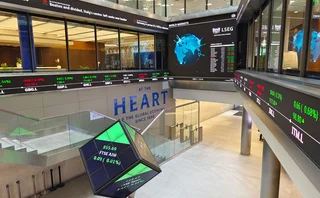
Derivatives client clearer of the year: BNP Paribas
Risk Awards 2023: When gas prices spiked, French bank provided much-needed credit to clients hit by jumbo margin calls

A graph plotting the price of European natural gas futures over the past five years could be mistaken for a chart showing bitcoin prices: a long stretch of rolling foothills followed by towering Himalayan peaks.
This extreme volatility in energy markets since the start of 2022 has piled pressure on parts of the financial system – not least in commodity clearing. Yet BNP Paribas’s actions during this period have provided a powerful reminder to clients of why exactly they pay their clearing fees.
The French bank was able to extend its clearing service to energy companies weighed down by huge margin calls, thanks to some bold decision-making on collateral and credit. For this, BNP Paribas wins the award for derivatives client clearer of the year.
After Russia invaded Ukraine on February 24, gas prices soared, as the market priced in concerns about a potential interruption of Russian gas supplies to Europe. The price of Ice’s TTF natural gas contract rose to €150 on March 2, having been below €40 for most of last year. But the worst was yet to come. Prices steadily began rising in the middle of June, spiking to €343 on August 26, just days before Russia choked off gas supplies to Europe by shutting the Nord Stream 1 pipeline, citing technical problems.
In turn, the two largest European commodity clearing houses, Ice Clear Europe and ECC, upped initial margin requirements significantly throughout much of the year, while volatile gas prices led to bumper variation margin calls. The increase in initial and variation margin led to energy utilities being called for billions of euros, money that some of them simply did not have at short notice.
According to regulatory disclosures, a single clearing member of Ice Clear Europe triggered a $7.8 billion variation margin call in the third quarter of last year.
We began developing extreme stress scenarios on the commodity side, which we used in tandem with our normal stress tests. This gave us a very good idea in terms of the worst-case liquidity requirements for clients
Kieron Smith, BNP Paribas
Large utilities generally hold high ratings from the credit rating agencies. They have assets, are profitable, and some are implicitly backed by the state. This means they can generally tap credit lines or supply bank guarantees, also known as letters of credit, to fund their derivatives trades.
But Ice Clear Europe and ECC do not accept letters of credit, as the European Market Infrastructure Regulation requires bank guarantees to be fully collateralised if they are to be posted to a central counterparty.
This is where BNP Paribas stepped in. As price volatility rose, it increased non-cash collateral limits, in some cases into the billions, allowing energy providers to provide bank guarantees instead of cash. In turn, BNP provided cash or acceptable collateral to the clearing houses. BNP also extended credit lines to customers who wanted to borrow directly to cover their margin calls.
An executive at a large European energy firm says: “The contribution of BNP Paribas to support our firm was just massive.”
But this support came with a cost for the French bank. For starters, the EU Capital Requirements Regulation penalises letters of credit on bank balance sheets because they are not classified as suitable collateral under standardised or internal model approaches, leading to a capital hit.
In addition, BNP Paribas was incurring some costs as it took on additional credit risk to source billions of dollars in liquidity, while sometimes delaying margin calls to its clients.
Be prepared
The warning signs for elevated risk in the commodities sector were already flashing prior to last year’s gas price spike, owing to events such as the February 2021 failure of the local power network Ercot in Texas, negative oil prices at the start of the Covid pandemic in March 2020, and more frequent extreme weather events.
BNP Paribas, like other banks, responded by stress-testing its exposures in extreme scenarios.
“We began developing extreme stress scenarios on the commodity side, which we used in tandem with our normal stress tests, which reflected far higher price movements,” says Kieron Smith, global head of derivatives execution and clearing and FX prime brokerage at BNP Paribas. “This gave us a very good idea in terms of the worst-case liquidity requirements for clients, including the corporate side.”
BNP’s clearing team worked closely with credit managers and the corporate finance team to build a picture of the amount of credit that had been extended and could further be extended for energy clients.
BNP also internally pre-agreed a significant increase on letters of credit on a case-by-case basis should certain scenarios in the energy market come to pass, allowing the bank to streamline the approval process when the Nord Stream shutdown hit markets. Where particularly large increases were needed, approvals went all the way up the chain from the first line of defence at the clearing arm, to the second line credit function and eventually to the management of the bank, according to Smith.
BNP’s longstanding relationships with utilities in several areas, not just in the clearing function, also helped the bank get comfortable with its increased risk appetite during the crisis.
“We have a dense network of senior bankers who have worked with these firms across business lines,” says Gaspard Bonin, deputy global head of derivatives execution and clearing at BNP Paribas. “Because you understand them and their business you can adequately adjust your support to them.”
Buy-side boost
Energy markets are not the only area where the bank’s clearing business has been making progress. BNP Paribas has continued to expand its derivatives execution and clearing business after a reboot in 2015, aggressively pursuing mandates around the globe.
A central plank of its strategy is to expand in the US – but competition remains tough. Required segregated customer assets in BNP’s US entity were up 29% for futures and 43% for swaps between the end of 2021 and the end of October last year, according to regulatory filings from US futures commission merchants. The bank has poached senior staff from rivals Citi and Morgan Stanley to help with its growth ambitions in the US, and snapped up former clients of Credit Suisse, which exited the clearing business after the default of Archegos Capital Management. BNP Paribas also integrated the global prime finance and electronic equities division of Deutsche Bank at the end of 2021.
But in terms of clearing, BNP remains far smaller than Barclays, the only other non-US bank with a serious presence in the country.
The French bank faces obstacles to growing quickly. Some of these obstacles are structural and relate to how the clearing business works, but some relate to achieving growth in a foreign market with powerful incumbents.
The US is a competitive market but we’re settling in for the long game
Kieron Smith, BNP Paribas
Request-for-proposal processes, where a buy-side firm invites clearing firms to pitch for business, on average occur once every few years. Even if a bank such as BNP wins a place on the pitch list, small and medium-sized investment firms often prefer clearing banks that they have pre-existing relationships with in other areas. In the US, this is far more likely to be a US bank.
Some clients also have a backup clearing provider, which is fully connected to the firm for trading and clearing, but doesn’t see much volume. This type of relationship often blossoms into a more active partnership, provided the client is happy with the service it is receiving. Once again, in a market with powerful incumbents, this is likely to be a US bank.
BNP may have more success with large buy-side firms which already have relationships with multiple US banks. Larger firms are more likely than smaller clients to be concerned about concentration risk, and are more willing to give a chance to a large, well-capitalised foreign competitor if it helps diversify counterparty risk. Many European pension funds have large US bank clearers on their books for exactly this reason.
Smith argues that the current entrenched position of US banks with clients in their home market is a result of the “passive drift” by US buy-side firms away from European banks, some of which exited the clearing business altogether. But that does not mean the future success of US banks is guaranteed.
“The fact that we are the European bank of choice is now a core selling point because US clients want to differentiate their relationships for risk diversification reasons,” he says.
Smith acknowledges that growth in the US will take sustained effort over years: “The US is a competitive market but we’re settling in for the long game,” he says.
Only users who have a paid subscription or are part of a corporate subscription are able to print or copy content.
To access these options, along with all other subscription benefits, please contact info@risk.net or view our subscription options here: http://subscriptions.risk.net/subscribe
You are currently unable to print this content. Please contact info@risk.net to find out more.
You are currently unable to copy this content. Please contact info@risk.net to find out more.
Copyright Infopro Digital Limited. All rights reserved.
As outlined in our terms and conditions, https://www.infopro-digital.com/terms-and-conditions/subscriptions/ (point 2.4), printing is limited to a single copy.
If you would like to purchase additional rights please email info@risk.net
Copyright Infopro Digital Limited. All rights reserved.
You may share this content using our article tools. As outlined in our terms and conditions, https://www.infopro-digital.com/terms-and-conditions/subscriptions/ (clause 2.4), an Authorised User may only make one copy of the materials for their own personal use. You must also comply with the restrictions in clause 2.5.
If you would like to purchase additional rights please email info@risk.net
More on Awards
Clearing house of the year: LCH
Risk Awards 2025: LCH outshines rivals in its commitment to innovation and co-operation with clearing members
Best use of machine learning/AI: CompatibL
CompatibL’s groundbreaking use of LLMs for automated trade entry earned the Best use of machine learning/AI award at the 2025 Risk Markets Technology Awards, redefining speed and reliability in what-if analytics
Markets Technology Awards 2025 winners’ review
Vendors jockeying for position in this year’s MTAs, as banks and regulators take aim at counterparty blind spots
Equity derivatives house of the year: Bank of America
Risk Awards 2025: Bank gains plaudits – and profits – with enhanced product range, including new variants of short-vol structures and equity dispersion
Law firm of the year: Linklaters
Risk Awards 2025: Law firm’s work helped buttress markets for credit derivatives, clearing and digital assets
Derivatives house of the year: UBS
Risk Awards 2025: Mega-merger expected to add $1 billion to markets revenues, via 30 integration projects
Interest rate derivatives house of the year: JP Morgan
Risk Awards 2025: Steepener hedges and Spire novations helped clients navigate shifting rates regime
Currency derivatives house of the year: UBS
Risk Awards 2025: Access to wealth management client base helped Swiss bank to recycle volatility and provide accurate pricing for a range of FX structures







